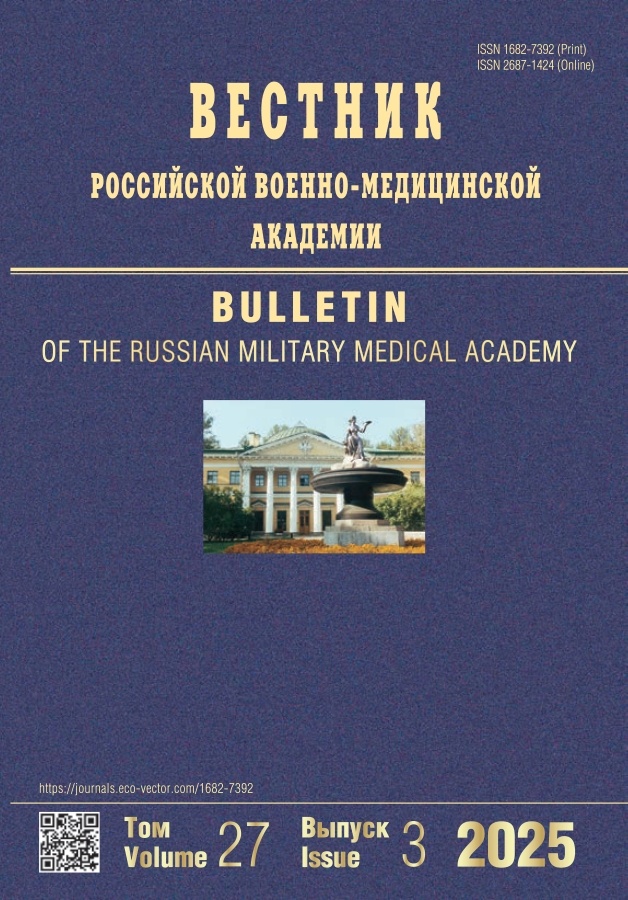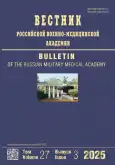Закономерности периодизации адаптационно-компенсаторных изменений компонентного состава тела обучающихся в военной образовательной организации
- Авторы: Семенов А.А.1
-
Учреждения:
- Военно-медицинская академия им. С.М. Кирова
- Выпуск: Том 27, № 3 (2025)
- Страницы: 361-366
- Раздел: Оригинальное исследование
- URL: https://bakhtiniada.ru/1682-7392/article/view/319567
- DOI: https://doi.org/10.17816/brmma645335
- EDN: https://elibrary.ru/BXYUCN
- ID: 319567
Цитировать
Аннотация
Обоснование. Фундаментальный, базовый характер и богатый научный инструментарий, разработанный в рамках концепции биологических ритмов, позволяет экстраполировать его на исследования компонентного состава тела для интерпретации его динамики.
Цель исследования — выявить закономерности периодизации изменений компонентного состава тела во время обучения в военной образовательной организации на основе анализа данных литературы и собственных оригинальных исследований.
Методы. В основу работы положены исследования анатомической научной школы профессора И.В. Гайворонского, выполненные на базе военной образовательной организации высшего образования, а также данные обзора литературы, дополняющие их. Оценивалась связанная выборка из 387 курсантов мужского пола и 27 девушек в возрасте от 17 до 23 лет (1–6-й курсы), проходивших обучение в период с 2017 по 2023 г. Измерение компонентного состава тела проводили с помощью анализатора компонентного состава тела Tanita MC-780 MA.
Результаты. Выявлены два ритма, обусловливающие закономерности адаптационно-компенсаторных изменений показателей компонентного состава. Ритм «относительного покоя» включает в себя показатели жирового компонента, общую жировую массу, уровень висцерального жира, метаболический возраст. Ритм «физических и интеллектуальных нагрузок», включающий в себя мышечную массу, массу тела без жира, саркопенический индекс. Для этого ритма характерна акрофаза, приходящаяся на периоды цикла, связанные с наибольшим функциональным напряжением, независимо от хронологической продолжительности рассматриваемого биологического цикла: это время физических и интеллектуальных нагрузок в графике дня курсантов, постовуляторная фаза в менструальном цикле девушек-курсанток, лето в годичном цикле, 1–2-й год обучения в военной образовательной организации. Для ритма «относительного покоя» характерна акрофаза, приходящаяся на периоды цикла, связанные с наименьшим функциональном напряжением: время пробуждения в графике дня курсантов, менструальная фаза у девушек, зима в годичном цикле, 4–5-й год обучения в военной образовательной организации.
Заключение. Дальнейшее развитие научной темы будет направлено на разработку индексов на основе периодизации динамики компонентного состава тела для решения прогностических, мониторинговых и скрининговых задач.
Ключевые слова: компонентный состав тела; биологические ритмы; адаптация; факторы военного труда; метаболический возраст; саркопенический индекс; акрофаза; военная образовательная организация.
Полный текст
Открыть статью на сайте журналаОб авторах
Алексей Анатольевич Семенов
Военно-медицинская академия им. С.М. Кирова
Автор, ответственный за переписку.
Email: vmeda-nio@mil.ru
ORCID iD: 0000-0002-1977-7536
SPIN-код: 1147-3072
канд. мед. наук, доцент
Россия, Санкт-Петербург, ул. Академика Лебедева, д. 6ЖСписок литературы
- Rostovtseva MV. Methodological Approaches to Studying Personal Social Adaptation. Krasnoyarsk: Siberian Federal University; 2021. (In Russ.) ISBN: 978-5-7638-4417-7 EDN: LMSSRQ
- Krishtop V, Nikonorova V, Gutsalova A, et al. Systematic comparison of main animal models of cerebral hypoperfusion. Tissues and Cells. 2022;75:101715. doi: 10.1016/j.tice.2021.101715
- Gaivoronsky IV, Semenov AA, Krishtop VV. Dynamics of body composition parameters in females during their training at a Military Medical University. Journal of Anatomy and Histopathology. 2024;13(2):9–15. doi: 10.18499/2225-7357-2024-13-2-9-15 EDN: WPWYNA
- Gaivoronsky IV, Semenov AA, Krishtop VV, et al. Sexual characteristics of physical development indicators during the training of cadets at a military university. Vestnik NOVSU. 2024;(2):165–178. doi: 10.34680/2076-8052.2024.2(136).165-178 EDN: OCAJKV
- Haugen HA, Melanson EL, Tran ZV, et al. Variability of measured resting metabolic rate. Am J Clin Nutr. 2003;78(6):1141–1145. doi: 10.1093/ajcn/78.6.1141
- Damiola F, Le Minh N, Preitner N, et al. Restricted feeding uncouples circadian oscillators in peripheral tissues from the central pacemaker in the suprachiasmatic nucleus. Genes Dev. 2000;14(23):2950–2961. doi: 10.1101/gad.183500
- Semenov AA. Patterns of physical development in cadets during military medical education. [dissertation]. Saint Petersburg; 2025. 44 p. Available from: https://rusneb.ru/catalog/000199_000009_013414115/
- Lavrentyeva DA, Afanasyeva AA. Changes to the indicators of bioimpedance analysis of body composition depending on the phases of the menstrual cycle in qualified swimmers aged 15–17 years. Lesgaft University Scientific Notes. 2023;5(219):237–241. doi: 10.34835/issn.2308-1961.2023.05.p237-241
- Komendantov II, Stafeeva AV. Fitness training content for weight loss in young women considering hormonal cycle characteristics. Problems of Modern Pedagogical Education. 2018;(59-2):83–86. EDN: XSHUMH
- Nikolaev VT. Effectiveness of periodization of the annual macrocycle in power training for girls. Science and Sport: Current Trends. 2020;8(2):32–43. doi: 10.36028/2308-8826-2020-8-2-32-44 EDN: OWPEXZ
- Fedorova OI, Pleshivtsev AI, Dronov SV. Individual changes of female physical status during fitness programs. Ulyanovsk Medical Biological Journal. 2018;(2):111–120. doi: 10.23648/UMBJ.2018.30.14054 EDN: XRHDOH
- Margolis LM, Murphy NE, Martini S, et al. Effects of winter military training on energy balance, whole-body protein balance, muscle damage, soreness and physical performance. Appl Physiol Nutr Metab. 2014;39(12):1395–1401. doi: 10.1139/apnm-2014-0212
- Ingelson-Filpula UA, Storey KB. Muscles in winter: epigenetics of metabolic arrest. Epigenomes. 2021;5(4):28. doi: 10.3390/epigenomes5040028
- Pugachev IYu, Paramzin VB, Raznovskaya SV, et al. Anticipatory adaptation and cross sensitization in human ontogenesis in physical and educational environment. Human. Sport. Medicine. 2022;22(S2):124–130. doi: 10.14529/hsm22s216 EDN: HPKGMR
- Novozhilova AA, Heregey AM, Merkulova AG. Specifics of studying occupational fatigue in work physiology. Russian Journal of Occupational Health and Industrial Ecology. 2022;62(4):238–246. doi: 10.31089/1026-9428-2022-62-4-238-246 EDN: VCTKWX
Дополнительные файлы








